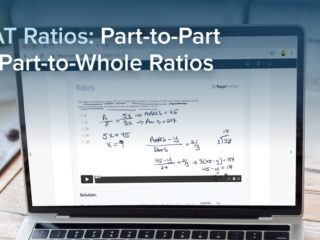Last Updated on May 11, 2023
GMAT OFFICIAL GUIDE DS
Solution:
We are given that on the number line, point R has coordinate r and point T has coordinate t, and we need to determine whether t < 0.
Statement One Alone:
-1 < r < 0
Statement one tells us that r is a negative proper fraction. However, without knowing anything about t, statement one is not sufficient to answer the question. We can eliminate answer choices A and D.
Statement Two Alone:
The distance between R and T is equal to r^2.
The distance between two values on the number line is the absolute value of the difference between the two values. Thus statement two gives us the equation |r – t| = r^2. However, without knowing anything about r and t, we can’t determine whether t is less than zero. For instance, r could be 2 and t could be -2; or r could be -2 and t could be 2. In each of the cases, |r – t| = 4 = r^2; but in one case t > 0 and in the other t < 0. Statement two is not sufficient to answer the question. We can eliminate answer choice B.
Statements One and Two Together:
Using statements one and two, we know that r is a negative proper fraction and |r – t| = r^2. Thus, r – t = r^2 OR r – t = -r^2. Solving each of these for t, we get: t = r – r^2 OR t = r + r^2.
Since r is a negative proper fraction, no matter what the value of r is, t will always be a negative number. For instance, if r = -1/2, then r^2 = 1/4 and t will either be -1/2 – 1/4 = -3/4 or -1/2 + 1/4 = -1/4.
The reason why t cannot be positive is that when we square r (a negative proper fraction), the value of r^2 (though positive) will be less than the absolute value of r. Recall that t = r – r^2 or t = r + r^2. When a positive proper fraction with a smaller absolute value is added to (or subtracted from) a negative proper fraction with a larger absolute value, the sum (or difference) will always be less than zero.
Answer: C



